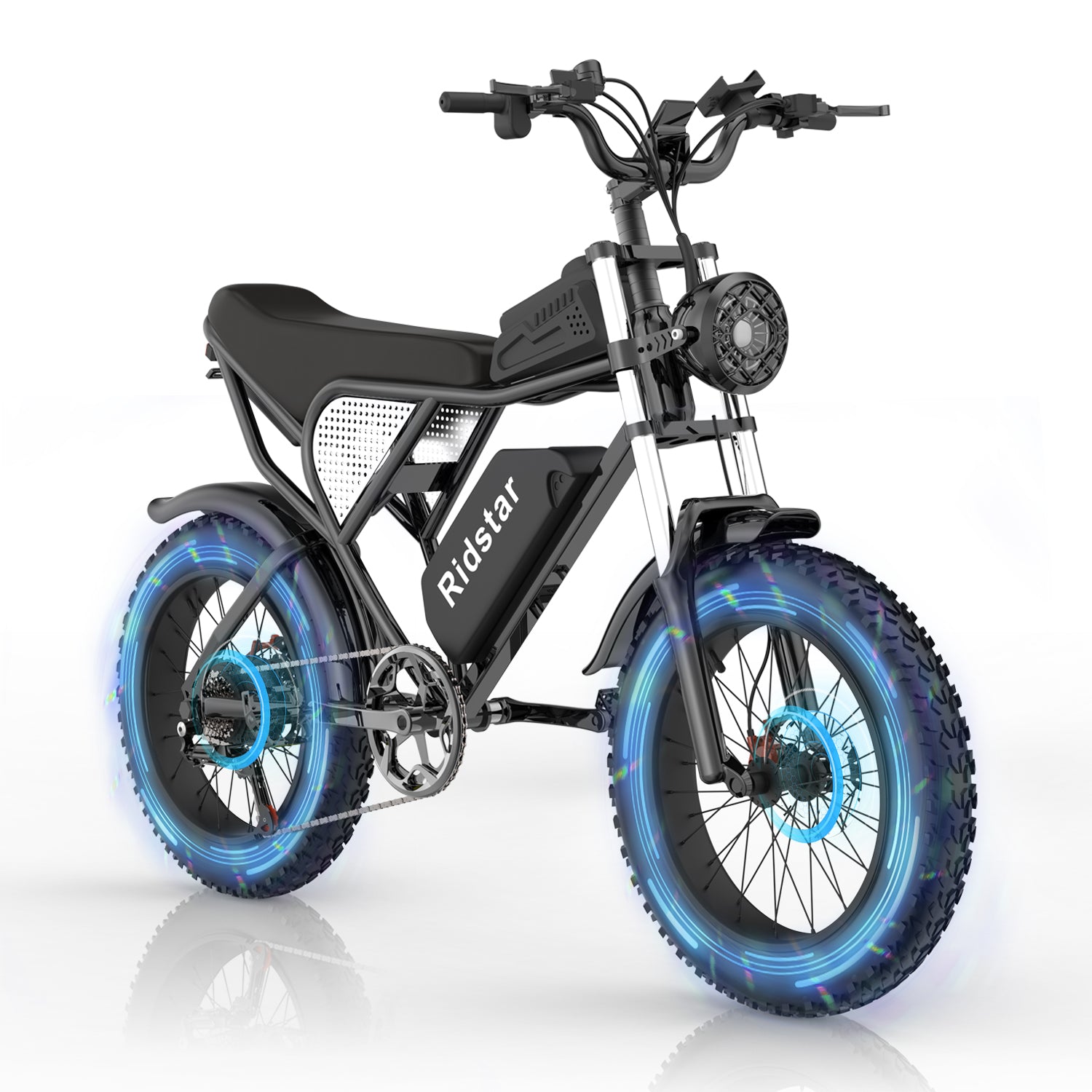How Do Electric Bikes Work and Why They're Revolutionizing Transportation
Electric bikes, commonly known as e-bikes, have rapidly gained popularity in recent years as a sustainable and convenient mode of transportation. They blend the benefits of traditional cycling with the added power of an electric motor, making them accessible to a wide range of riders. In this comprehensive guide, we will delve into the inner workings of electric bikes, exploring their key components, functioning, advantages, and their impact on modern transportation.
The Rise of Electric Bikes
E-bikes have emerged as a solution to several challenges faced by urban commuters, outdoor enthusiasts, and eco-conscious individuals. The surge in e-bike adoption can be attributed to various factors, including advancements in battery technology, environmental concerns, rising fuel costs, and the desire for healthier lifestyle choices.
Types Of Electric Bikes
One of the key factors contributing to their widespread adoption is the diverse range of types available, each tailored to specific riding styles, preferences, and terrain. In this comprehensive exploration of the types of electric bikes, we will delve into the unique features, functionalities, and benefits of various e-bike categories, ranging from city commuters to rugged off-road adventurers.
1. City Commuter E-Bikes: City commuter e-bikes are designed to provide a comfortable and efficient riding experience for urban dwellers navigating bustling streets and crowded bike lanes. These e-bikes typically feature sleek and minimalist designs, integrated lights for enhanced visibility, and practical accessories such as fenders and racks for carrying cargo or groceries. With their upright riding position and ergonomic handlebars, city commuter e-bikes prioritize rider comfort and convenience, making them ideal for daily commuting or running errands around town. The motor systems on these bikes are often optimized for urban environments, providing smooth acceleration and responsive assistance to tackle hills and city traffic effortlessly.
2. Mountain E-Bikes: Mountain e-bikes, also known as electric mountain bikes or eMTBs, are built to conquer rugged trails, steep inclines, and challenging terrain with ease. These off-road adventurers feature durable frames, full-suspension systems, and aggressive knobby tires for maximum traction and control in the wilderness. Mountain e-bikes are equipped with powerful motors and high-capacity batteries to assist riders during demanding climbs and technical descents, allowing them to explore remote trails and conquer obstacles that would otherwise be inaccessible on conventional bikes. Whether shredding singletrack trails or tackling rocky terrain, mountain e-bikes offer adrenaline-fueled adventures for thrill-seeking riders.
3. Folding E-Bikes: Folding e-bikes are a practical and space-saving solution for commuters, travelers, and urbanites with limited storage space or the need for portability. These compact and lightweight e-bikes can be easily folded or collapsed for convenient storage in small apartments, car trunks, or public transportation. Despite their compact size, folding e-bikes offer impressive performance and functionality, with features such as adjustable seat posts, quick-release mechanisms, and efficient folding mechanisms for easy transportation. Whether navigating city streets or exploring new destinations, folding e-bikes provide flexibility and convenience for riders on the go.
4. Electric Road Bikes: Electric road bikes combine the speed and efficiency of traditional road cycling with the added assistance of electric power, offering a thrilling riding experience for fitness enthusiasts, endurance riders, and road racing aficionados. These lightweight and aerodynamic e-bikes feature sleek designs, drop handlebars, and narrow tires for minimal rolling resistance and maximum efficiency on paved roads. Electric road bikes are equipped with high-performance motors and long-lasting batteries to provide seamless assistance during long-distance rides, steep climbs, and high-speed sprints. Whether training for a race or embarking on a scenic road trip, electric road bikes deliver an exhilarating ride that redefines the boundaries of traditional cycling.
5. Cargo E-Bikes: Cargo e-bikes, also known as electric cargo bikes or e-cargo bikes, are designed to transport heavy loads, groceries, children, or cargo with ease, making them ideal for families, businesses, and urban logistics. These sturdy and versatile e-bikes feature extended frames, robust racks, and spacious cargo compartments capable of carrying bulky items or multiple passengers. Cargo e-bikes are equipped with powerful motors and long-range batteries to provide ample assistance while hauling heavy loads, ensuring a smooth and efficient ride for both the rider and the cargo. Whether running errands, commuting with children, or making deliveries, cargo e-bikes offer a sustainable and practical transportation solution for urban living.
6. Recreational E-Bikes: Recreational e-bikes are versatile and multi-purpose electric bikes designed for leisurely rides, casual commuting, and scenic adventures. These all-rounders come in various styles and configurations, from cruiser bikes with laid-back frames to hybrid bikes with a blend of road and mountain features. Recreational e-bikes prioritize comfort, stability, and ease of use, making them suitable for riders of all ages and abilities. With their adjustable saddle heights, wide handlebars, and user-friendly controls, recreational e-bikes offer a relaxed and enjoyable riding experience for exploring neighborhood trails, coastal paths, or scenic countryside routes.
7. Electric Fat Bikes: Electric fat bikes are rugged and versatile off-road machines equipped with oversized tires, sturdy frames, and powerful motors, making them capable of tackling diverse terrain, including snow, sand, mud, and gravel. These go-anywhere e-bikes provide unmatched stability, traction, and flotation, allowing riders to venture off the beaten path and explore remote landscapes with confidence. Electric fat bikes are popular among outdoor enthusiasts, adventurers, and wilderness explorers seeking new challenges and experiences in nature. Whether conquering snowy trails in winter or navigating sandy beaches in summer, electric fat bikes offer year-round fun and excitement for adventurous souls.
Understanding the Components
-
Frame: The frame of an e-bike provides structural support and houses key components such as the battery, motor, and electronics. Modern e-bike frames are designed to be sturdy yet lightweight, ensuring durability and maneuverability.
-
Motor: The electric motor is the heart of an e-bike, providing propulsion assistance to the rider. These motors are typically located in one of three places: the hub of the front wheel (front hub motor), the hub of the rear wheel (rear hub motor), or integrated into the pedal cranks (mid-drive motor). Each motor location offers unique advantages in terms of weight distribution, torque delivery, and overall ride feel.
-
Battery: E-bikes are powered by rechargeable lithium-ion batteries, which store electrical energy to drive the motor. Battery capacity is measured in watt-hours (Wh), with higher capacity batteries providing longer range per charge. Modern e-bikes feature removable batteries for easy charging and maintenance.
-
Controller: The controller acts as the brain of the e-bike, regulating the flow of electrical energy from the battery to the motor. It controls parameters such as speed, torque, and power output, ensuring a smooth and efficient riding experience. Riders can adjust settings and modes through the controller interface.
-
Throttle and Pedal Assist System (PAS): E-bikes offer two primary modes of operation. The throttle allows riders to control the motor's power output directly, similar to a motorcycle throttle. The Pedal Assist System (PAS) enhances the rider's pedaling efforts by providing proportional assistance from the motor based on selected assistance levels.
-
Display Panel: The display panel mounted on the handlebars provides real-time information to the rider, including speed, distance traveled, battery level, assistance mode, and other relevant data. Some advanced displays also offer GPS navigation, smartphone connectivity, and fitness tracking features.
-
Brakes: E-bikes are equipped with traditional mechanical or hydraulic brakes, ensuring safe and responsive stopping power. Some e-bikes feature regenerative braking, which converts kinetic energy into electrical energy during deceleration, helping to recharge the battery and improve overall efficiency.
How Electric Bikes Work
-
Power Activation: To activate an e-bike, the rider typically turns on the battery and controller using a key or button interface. Once activated, the e-bike is ready for operation.
-
Pedaling or Throttle Input: Riders can start moving the e-bike by either pedaling or using the throttle. Pedal-assist e-bikes detect pedaling motion and provide assistance accordingly, while throttle-controlled e-bikes deliver power based on throttle input.
-
Motor Engagement: When the rider initiates pedaling or throttle input, the controller signals the motor to engage and provide assistance. The motor's power output is determined by the selected assistance mode and the rider's input intensity.
-
Assistance Modes: E-bikes offer multiple assistance modes, ranging from low to high power output. Riders can choose their preferred mode based on terrain, desired speed, and battery conservation goals.
-
Battery Management: The controller continuously monitors the battery's status, adjusting power delivery to optimize performance and prevent overcharging or overheating. Riders can view battery level and range information on the display panel.
-
Regenerative Braking (Optional): Some e-bikes feature regenerative braking, which captures energy during braking or coasting and redirects it back to the battery. This technology improves overall energy efficiency and extends riding range.
-
Safety Features: E-bikes are equipped with safety features such as automatic cut-off switches, lights, and audible signals to enhance rider visibility and ensure safe operation, especially in low-light conditions or high-traffic areas.
Advantages of Electric Bikes
-
Efficient Transportation: E-bikes offer a convenient and efficient mode of transportation for commuting, running errands, and recreational activities. They enable riders to cover longer distances with less effort and time compared to traditional bicycles.
-
Health and Fitness Benefits: Despite motor assistance, e-bikes provide a form of low-impact exercise that promotes cardiovascular health, muscle strength, and overall well-being. Riders can adjust assistance levels to match their fitness goals and energy levels.
-
Environmental Impact: E-bikes produce zero emissions during operation, making them environmentally friendly alternatives to cars and motorcycles. By reducing fossil fuel consumption and air pollution, e-bikes contribute to cleaner and healthier urban environments.
-
Cost Savings: E-bikes offer significant cost savings over time, including reduced fuel expenses, parking fees, insurance premiums, and vehicle maintenance costs. They are also eligible for incentives and subsidies in many regions, further lowering ownership costs.
-
Accessibility and Inclusivity: E-bikes make cycling more accessible to a wider range of people, including older adults, individuals with physical limitations, and those seeking an easier transition into cycling. They enable riders to tackle hills, headwinds, and longer distances with confidence and comfort.
-
Community and Connectivity: E-bikes promote social interaction and community engagement by encouraging group rides, cycling events, and shared mobility initiatives. They also integrate technology features such as GPS navigation, Bluetooth connectivity, and smartphone apps, enhancing the overall riding experience.
The Future of Electric Bikes
As technology continues to evolve, electric bikes are poised to play a crucial role in shaping the future of urban mobility and sustainable transportation. Innovations in battery technology, motor efficiency, lightweight materials, and smart connectivity will drive further advancements in e-bike design and performance.
Conclusion
Electric bikes represent a transformative shift in how we approach transportation, fitness, and environmental sustainability. By harnessing the power of electric motors, e-bikes offer a practical, enjoyable, and eco-friendly alternative to conventional vehicles. Understanding how electric bikes work empowers individuals to embrace this innovative mode of travel and experience its myriad benefits firsthand. Whether for daily commuting, weekend adventures, or leisurely rides, e-bikes are revolutionizing the way we move and explore our world.



